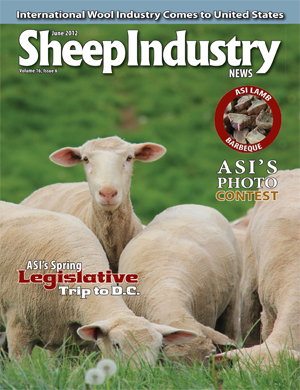Research on Susceptibility to OPP at USMARC
(June 1, 2012) Ovine progressive pneumonia virus (OPPV) and Visna/Maedi virus (VMV) cause an incurable, slow-acting, wasting disease that affects millions of sheep worldwide. These are ovine lentivirus strains that target the immune system causing persistent retroviral infections. The disease affects multiple tissues, including those of the respiratory and central nervous systems. In North America, OPPV is one of the most costly diseases affecting sheep due to decreased productivity, “hard bag,” lameness, and early culling of ewes. Previous research at USMARC showed that infected ewes are 20-percent less productive than uninfected ewes. A study reported in 2003 by USDA’s Animal and Plant Health Inspection Service showed that 36 percent of sheep operations and 24 percent of all animals tested in the United States were infected with the virus. Once infected with the virus, sheep are carriers throughout life as there is no effective treatment or vaccine. USMARC’s aim was to identify sheep genes that influence OPPV infection.
A Genetic Approach
We designed a genome-wide association study to test whether or not sheep have genetic variation that protects against OPPV infection. Our study became possible with development of the OvineSNP50 BeadChip in 2009 by the International Sheep Genomics Consortium (ISGC). The OvineSNP50 BeadChip is a commercially available set of 50,000 genotyping tests. These tests were applied to matched pairs of ewes that had received a lifetime of natural OPPV exposure at USMARC. Each pair of sheep contained one infected ewe and an uninfected ewe of the same age, breed and flock. In other words, they were matched “case-control” pairs.
The Findings
Using this approach, they discovered a gene (TMEM154) that affects susceptibility to OPPV infection1. There were three major variants (called haplotypes 1, 2 and 3) of the TMEM154 gene. In more than 8,000 sheep tested, 97 percent had some combination of these three haplotypes. Haplotypes 2 and 3 were strongly associated with OPPV infection and considered to be “susceptibility alleles”. Only one copy of haplotype 2 or 3 was needed to increase susceptibility to OPPV infection. Studies are underway at USMARC to determine whether or not haplotypes 2 and 3 are expressed in an additive or dominant manner compared to haplotype 1. In contrast to ewes with one copy of haplotype 2 or 3, those with two copies of haplotype 1 were many times less likely to be infected. These findings were quickly confirmed with the help of other USDA scientists at the Animal Disease Research Unit in Pullman, Wash., and those at the U.S. Sheep Experiment Station in Dubois, Idaho. Researchers suggest that one genetic strategy to reduce OPPV is to reduce the overall frequency of TMEM154 haplotypes 2 and 3.
They also observed six additional TMEM154 haplotypes that occur at low frequencies, yet may also confer low susceptibility like haplotype 1. For example, it appears that haplotype 4 encodes a non-functional protein and may confer OPPV resistance. Although rare, sheep with two copies of haplotype 4 (referred to as “4,4 knockouts”) have remained uninfected despite a lifetime of significant OPPV exposure. Because the scientific and production information on 4,4 knockouts are very limited, additional research is needed to determine the effects of haplotype 4 before any recommendations can be made to use this haplotype to lower OPPV infection. Currently, the effects of TMEM154 variants on OPPV infection rates are being studied at USMARC under conditions of natural challenge to provide selection guidelines for industry use.
The Caveat
Although these findings are promising, OPPV is a highly adaptable virus and it is not known if selection for TMEM154 haplotype 1 will reduce the incidence of OPPV infection in all flocks. To that end, research is being conducted at USMARC to determine if some OPPV strains have adapted to infect sheep with TMEM154 haplotype 1. Other sheep genes are also being evaluated as possible gateways for OPPV infection in the presence of specific TMEM154 haplotypes. Additionally, adverse production conditions like high animal density, indoor housing with poor ventilation and moist climates may enhance virus transmission and overcome sheep genetic resistance.
Opportunity for Genetic Testing
In collaboration with animal genotype provider GeneSeek®, a Neogen Corporation Company based in Lincoln, Neb., USMARC is developing a TMEM154 genotyping test for commercial use. Scientists at both institutions have validated the test performance in USMARC sheep and the results will be submitted to a scientific journal for publication. The aim of this test is to correctly determine the TMEM154 haplotypes for each animal tested. The genetic test was expected to be available to producers last month. Additional information on sample submission and testing will be available at http://www.neogen.com/GeneSeek/ .
As strategies for TMEM154 genetic testing are evaluated under field conditions, additional genetic guidelines for reducing the incidence of OPPV infection will emerge. Ultimately, information and products of this research will be used to select for animals less likely to be infected by OPPV.
Mention of trade names or commercial products in this publication is solely for the purpose of providing specific information and does not imply recommendation or endorsement by the USDA to the exclusion of others that may also be suitable.
1Heaton et al., 2012 PLoS Genetics http://www.plosgenetics.org/article/info%3Adoi%2F10.1371% .


